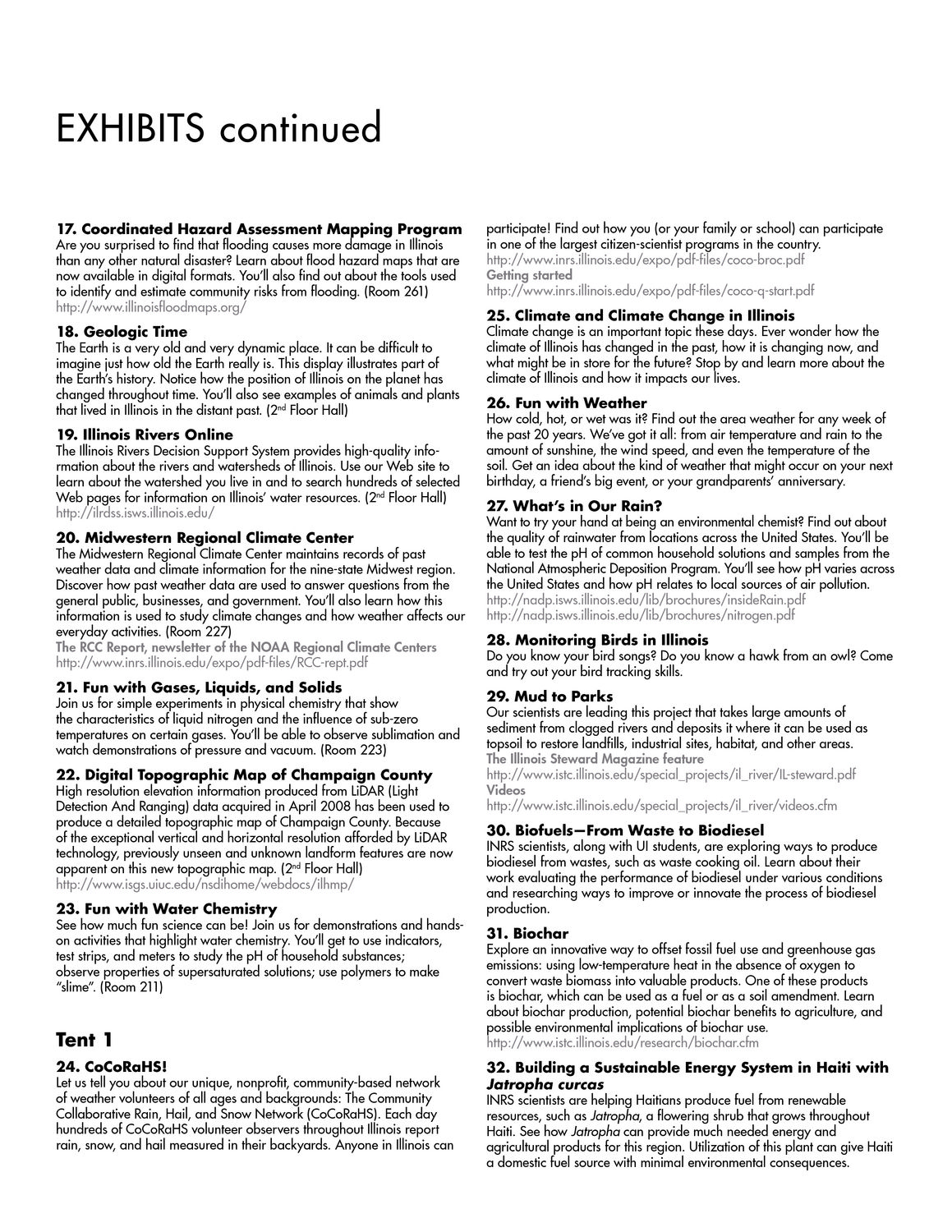Caption: IRNS Open House Guide - 2010
This is a reduced-resolution page image for fast online browsing.

EXTRACTED TEXT FROM PAGE:
ExHIBITS continued 17. Coordinated Hazard assessment Mapping Program Are you surprised to find that flooding causes more damage in Illinois than any other natural disaster? Learn about flood hazard maps that are now available in digital formats. You’ll also find out about the tools used to identify and estimate community risks from flooding. (Room 261) http://www.illinoisfloodmaps.org/ participate! Find out how you (or your family or school) can participate in one of the largest citizen-scientist programs in the country. http://www.inrs.illinois.edu/expo/pdf-files/coco-broc.pdf Getting started http://www.inrs.illinois.edu/expo/pdf-files/coco-q-start.pdf 18. geologic Time 25. Climate and Climate Change in illinois The Earth is a very old and very dynamic place. It can be difficult to imagine just how old the Earth really is. This display illustrates part of the Earth’s history. Notice how the position of Illinois on the planet has changed throughout time. You’ll also see examples of animals and plants that lived in Illinois in the distant past. (2nd Floor Hall) The Illinois Rivers Decision Support System provides high-quality information about the rivers and watersheds of Illinois. Use our Web site to learn about the watershed you live in and to search hundreds of selected Web pages for information on Illinois’ water resources. (2nd Floor Hall) http://ilrdss.isws.illinois.edu/ Climate change is an important topic these days. Ever wonder how the climate of Illinois has changed in the past, how it is changing now, and what might be in store for the future? Stop by and learn more about the climate of Illinois and how it impacts our lives. 26. Fun with Weather 19. illinois Rivers Online How cold, hot, or wet was it? Find out the area weather for any week of the past 20 years. We’ve got it all: from air temperature and rain to the amount of sunshine, the wind speed, and even the temperature of the soil. Get an idea about the kind of weather that might occur on your next birthday, a friend’s big event, or your grandparents’ anniversary. 27. What’s in Our Rain? 20. Midwestern Regional Climate Center The Midwestern Regional Climate Center maintains records of past weather data and climate information for the nine-state Midwest region. Discover how past weather data are used to answer questions from the general public, businesses, and government. You’ll also learn how this information is used to study climate changes and how weather affects our everyday activities. (Room 227) The RCC Report, newsletter of the NOAA Regional Climate Centers http://www.inrs.illinois.edu/expo/pdf-files/RCC-rept.pdf Want to try your hand at being an environmental chemist? Find out about the quality of rainwater from locations across the United States. You’ll be able to test the pH of common household solutions and samples from the National Atmospheric Deposition Program. You’ll see how pH varies across the United States and how pH relates to local sources of air pollution. http://nadp.isws.illinois.edu/lib/brochures/insideRain.pdf http://nadp.isws.illinois.edu/lib/brochures/nitrogen.pdf 28. Monitoring Birds in illinois 21. Fun with gases, liquids, and Solids Do you know your bird songs? Do you know a hawk from an owl? Come and try out your bird tracking skills. Join us for simple experiments in physical chemistry that show the characteristics of liquid nitrogen and the influence of sub-zero temperatures on certain gases. You’ll be able to observe sublimation and watch demonstrations of pressure and vacuum. (Room 223) 29. Mud to Parks 22. digital Topographic Map of Champaign County High resolution elevation information produced from LiDAR (Light Detection And Ranging) data acquired in April 2008 has been used to produce a detailed topographic map of Champaign County. Because of the exceptional vertical and horizontal resolution afforded by LiDAR technology, previously unseen and unknown landform features are now apparent on this new topographic map. (2nd Floor Hall) http://www.isgs.uiuc.edu/nsdihome/webdocs/ilhmp/ Our scientists are leading this project that takes large amounts of sediment from clogged rivers and deposits it where it can be used as topsoil to restore landfills, industrial sites, habitat, and other areas. The Illinois Steward Magazine feature http://www.istc.illinois.edu/special_projects/il_river/IL-steward.pdf Videos http://www.istc.illinois.edu/special_projects/il_river/videos.cfm 30. Biofuels—From Waste to Biodiesel 23. Fun with Water Chemistry See how much fun science can be! Join us for demonstrations and handson activities that highlight water chemistry. You’ll get to use indicators, test strips, and meters to study the pH of household substances; observe properties of supersaturated solutions; use polymers to make “slime”. (Room 211) INRS scientists, along with UI students, are exploring ways to produce biodiesel from wastes, such as waste cooking oil. Learn about their work evaluating the performance of biodiesel under various conditions and researching ways to improve or innovate the process of biodiesel production. 31. Biochar Tent 1 24. CoCoRaHS! Let us tell you about our unique, nonprofit, community-based network of weather volunteers of all ages and backgrounds: The Community Collaborative Rain, Hail, and Snow Network (CoCoRaHS). Each day hundreds of CoCoRaHS volunteer observers throughout Illinois report rain, snow, and hail measured in their backyards. Anyone in Illinois can Explore an innovative way to offset fossil fuel use and greenhouse gas emissions: using low-temperature heat in the absence of oxygen to convert waste biomass into valuable products. One of these products is biochar, which can be used as a fuel or as a soil amendment. Learn about biochar production, potential biochar benefits to agriculture, and possible environmental implications of biochar use. http://www.istc.illinois.edu/research/biochar.cfm 32. Building a Sustainable energy System in Haiti with Jatropha curcas INRS scientists are helping Haitians produce fuel from renewable resources, such as Jatropha, a flowering shrub that grows throughout Haiti. See how Jatropha can provide much needed energy and agricultural products for this region. Utilization of this plant can give Haiti a domestic fuel source with minimal environmental consequences.
|